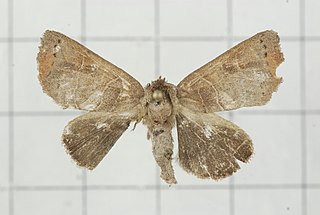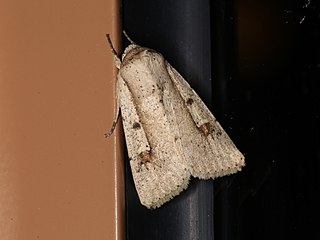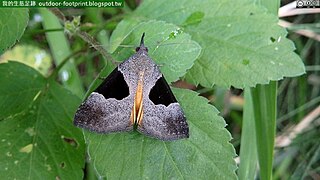
The bell pepper is the fruit of plants in the Grossum cultivar group of the species Capsicum annuum. Cultivars of the plant produce fruits in different colors, including red, yellow, orange, green, white, and purple. Bell peppers are sometimes grouped with less pungent chili varieties as "sweet peppers". While they are fruits—botanically classified as berries—they are commonly used as a vegetable ingredient or side dish. The fruits of the Capsicum genus are categorized as chili peppers.

The Arctiinae are a large and diverse subfamily of moths with around 11,000 species found all over the world, including 6,000 neotropical species. This subfamily includes the groups commonly known as tiger moths which usually have bright colours, footmen which are usually much drabber, lichen moths, and wasp moths. Many species have "hairy" caterpillars that are popularly known as woolly bears or woolly worms. The scientific name Arctiinae refers to this hairiness. Some species within the Arctiinae have the word tussock in their common name because they have been misidentified as members of the Lymantriinae subfamily based on the characteristics of the larvae.

Polygonia c-album, the comma, is a food generalist (polyphagous) butterfly species belonging to the family Nymphalidae. The angular notches on the edges of the forewings are characteristic of the genus Polygonia, which is why species in the genus are commonly referred to as anglewing butterflies. Comma butterflies can be identified by their prominent orange and dark brown/black dorsal wings.

Acraea terpsicore, the tawny coster, is a small, 53–64 millimetres (2.1–2.5 in), leathery-winged butterfly common in grassland and scrub habitats. It belongs to the Nymphalidae or brush-footed butterfly family. It has a weak fluttery flight. It is avoided by most insect predators. This species and the yellow coster are the only two Indian representatives of the predominantly African tribe Acraeini. It is found in India, Sri Lanka, Maldives to Myanmar, Thailand, Laos, Cambodia, Vietnam, Singapore, and recently Australia

Hyblaea puera, the teak defoliator, is a moth and cryptic species complex native to South Asia and South-east Asia. It was first described by Pieter Cramer in 1777. The species has also been recently reported to be present in Central America and Africa. The caterpillar feeds on teak and other trees. It is considered to be one of the major teak pests around the world.

Eriogaster lanestris, commonly known as the small eggar, is a moth of the family Lasiocampidae that is found across the Palearctic. Unlike many other members of the Lasiocampidae, the small eggar is a social insect. Historically, only eusocial insects like ants, bees, and termites were thought to exhibit complex social organization and communication systems. However, research since the late 20th century has found that E. lanestris, among a number of other phylogenetically related moth and butterfly species, demonstrates social behaviors as well. Larvae spend nearly their entire development in colonies of about 200 individuals, and this grouped social structure offers a number of benefits, from thermoregulation to increased foraging success.
Cryptophlebia ombrodelta, the litchi fruit moth or macadamia nut borer, is a moth of the family Tortricidae. The species was first described by Oswald Bertram Lower in 1898. It is native to India, Sri Lanka, Nepal, Indonesia, China, Taiwan, Vietnam, Thailand, western Malaysia, New Guinea, the Philippines, Japan, Guam, the Caroline Islands, Australia and has been introduced to Hawaii.

Elasmopalpus is a monotypic snout moth genus described by Émile Blanchard in 1852. Its single species, Elasmopalpus lignosellus, the lesser cornstalk borer, was described by Philipp Christoph Zeller in 1852. It is found from the southern United States to Mexico, Central America and South America. It is also found on the Bahamas.

Homona coffearia, the tea tortrix or camellia tortrix, is a moth of the family Tortricidae. The species was first described by Nietner in 1861. It is widely distributed in the Oriental region.

Scirpophaga incertulas, the yellow stem borer or rice yellow stem borer, is a species of moth of the family Crambidae. It was described by Francis Walker in 1863. It is found in Afghanistan, Nepal, north-eastern India, Sri Lanka, Bangladesh, Myanmar, Vietnam, Thailand, Malaysia, Singapore, Sumatra, Java, Borneo, Sumba, Sulawesi, the Philippines, Taiwan, China and Japan.

Polydesma umbricola, the monkeypod moth or large tabby, is a species of moth in the family Erebidae. The species is found in southern Europe, Africa, Asia Minor to southern Asia, of India, Sri Lanka, Maldives, the Andaman Islands, including many Indian Ocean islands, like Coëtivy Island, Aldabra, Assumption Island, Madagascar and on Hawaii.

Atteva fabriciella, the Ailanthus webworm moth, is a moth of the family Attevidae. It is found in China, India and Sri Lanka. It is considered as one of deadliest plant pest on Ailanthus species.
Suana concolor is a moth of the family Lasiocampidae first described by Francis Walker in 1855. It is found in India and Sri Lanka, to South China, Java, Borneo and the Philippines.

Clostera restitura is a moth of the family Notodontidae first described by Francis Walker in 1865. It is found in Oriental tropics of India, Sri Lanka, and from Hong Kong to Sundaland.

Polytela gloriosae, the Indian lily moth or lily caterpillar, is a moth of the family Noctuidae. The species was first described by Johan Christian Fabricius in 1781. It is found in Sri Lanka, India and probably in Indonesia.

Leucania yu is a moth of the family Noctuidae first described by Achille Guenée in 1852. It is found in Oriental tropics of India, Sri Lanka, the Andaman Islands, Hong Kong, Indonesia, the Philippines, Taiwan east to Australia, Fiji and Tonga.

Dichromia orosia, sometimes as Dichromia sagitta, is a moth of the family Erebidae first described by Edward Meyrick in 1913. It is found in Sri Lanka and Australia. The caterpillar is a pest of Marsdenia species, Tylophora asthntatica and Tylophora indica.

Parasa bicolor, the green rice moth, is a moth of the family Limacodidae. The species was first described by Francis Walker in 1855. It is found in Sri Lanka, India, Nepal, Pakistan, Myanmar, Laos, Taiwan, Vietnam, Malaysia, Java, China and Taiwan.
Pteroma plagiophleps is a moth of the family Psychidae first described by George Hampson in 1892. It is found in India, Bangladesh, Sri Lanka, and Indonesia.
Nola analis is a moth of the family Nolidae first described by Wileman and West in 1928. It is found in India, Sri Lanka and Hong Kong.





















